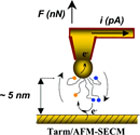Publication
643
ACS Nano
3, 349-353, 2009.
DOI:
10.1021/nn8007788
|
|
|
|
|
 |
Electrochemical Atomic-Force Microscopy Using a Tip-Attached Redox Mediator. Proof-of-Concept and Perspectives for Functional Probing of Nanosystems. |
|
|
|
|
|
Agnes Anne, Christophe Demaille*, and Cedric Goyer
Laboratoire d‘Electrochimie Moléculaire, UMR CNRS 7591 Université Paris Diderot (Paris 7), 15 rue Jean-Antoine de Baîf, 75205 Paris Cedex 13, France
This paper presents the first steps toward the development of a new type of high-resolution AFM-SECM microscopy which relies on the use of tip-attached redox-labeled polymer chains as mediators to probe the local electrochemical reactivity of a planar substrate at the nanoscale. Submicrometer-sized combined gold AFM-SECM probes were functionalized by linear, nanometer-sized, flexible, PEG3400 chains bearing a ferrocene (Fc) redox label at their free end. Analysis of the force and current approach curves recorded when such Fc-PEGylated probes (tips) were approached to a bare gold substrate allowed the presence of the Fc-PEG chains at the very tip end of the combined probes to be specifically demonstrated. It also allowed the chain coverage, configuration, and dynamics to be determined. When the Fc-PEGylated probe is positioned some  5 nm above the substrate, only a few hundred chains are actually electrochemically contacting the surface, thus reducing the size of the tip−substrate interaction area to 20−40 nm. Most importantly, we have shown that the tip-borne PEG chains are flexible enough to allow their Fc heads to efficiently “sense” locally the electrochemical reactivity of the substrate, thus validating the working principle of the new AFM-SECM microscopy we propose. This innovative microscopy, we label Tarm (for tip-attached redox mediator)/AFM-SECM, should be particularly suitable for probing the activity of slowly functioning nanometer-sized active sites on surfaces, such as individual enzyme molecules, because it is, by design, free of the diffusional constraints which hamper the characterization of such nanosystems by classical SECM. 5 nm above the substrate, only a few hundred chains are actually electrochemically contacting the surface, thus reducing the size of the tip−substrate interaction area to 20−40 nm. Most importantly, we have shown that the tip-borne PEG chains are flexible enough to allow their Fc heads to efficiently “sense” locally the electrochemical reactivity of the substrate, thus validating the working principle of the new AFM-SECM microscopy we propose. This innovative microscopy, we label Tarm (for tip-attached redox mediator)/AFM-SECM, should be particularly suitable for probing the activity of slowly functioning nanometer-sized active sites on surfaces, such as individual enzyme molecules, because it is, by design, free of the diffusional constraints which hamper the characterization of such nanosystems by classical SECM. |

